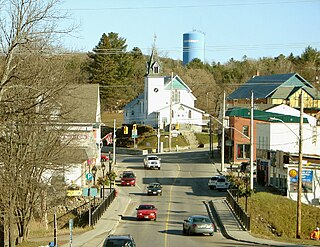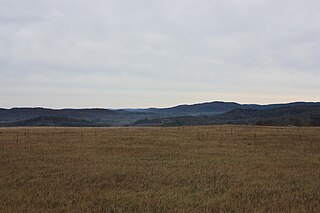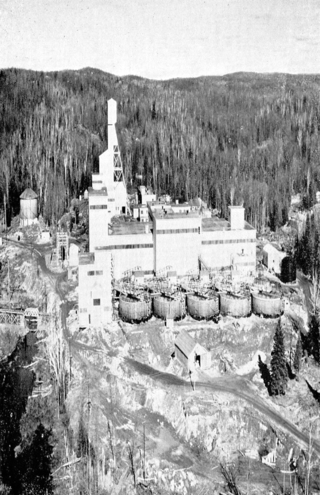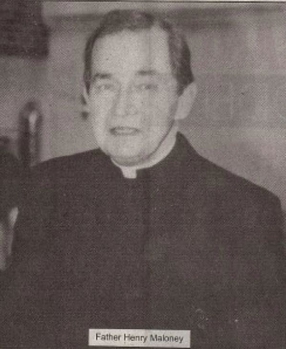Related Research Articles

Haliburton is a county of Ontario, Canada, known as a tourist and cottage area in Central Ontario for its scenery and for its resident artists. Minden Hills is the county seat. Haliburton County and the village of Haliburton are named after Thomas Chandler Haliburton, author, statesman, and the first chairman of the Canadian Land and Emigration Company.

Bancroft is a town located on the York River in Hastings County in the Canadian province of Ontario. It was first settled in the 1850s by United Empire Loyalists and Irish immigrants. From the mid-1950s to about 1982, mining was the primary industry. A village until 1999, Bancroft then merged with Dungannon Township to form the Town of Bancroft. The population at the time of the 2016 Census was 3,881; the regional population is 40,000. There are 150,000 visitors to Bancroft, annually.

The United Townships of Dysart, Dudley, Harcourt, Guilford, Harburn, Bruton, Havelock, Eyre and Clyde, commonly known as the Municipality of Dysart et al, is a municipality in Haliburton County in Central Ontario, Canada. The original townships were of the Canadian Land and Emigration Company.
King's Highway 118, commonly referred to as Highway 118, is a provincially maintained highway in the Canadian province of Ontario. The route travels across South-Central Ontario between Highway 11 near Bracebridge and Highway 28 near Bancroft. Several communities are served by the route, including Uffington, Vankoughnet, Carnarvon, West Guilford, Haliburton Village, Tory Hill, Cardiff and Paudash.

Madawaska Mine (previously known as Faraday Mine) is a decommissioned underground uranium mine in Faraday, near the town of Bancroft, Ontario, which produced 9 million pounds (4,082 tonnes) of U3O8 concentrate, at an average ore grade of 0.1074%, during its two periods of production.

Faraday is a township in the Canadian province of Ontario, located within Hastings County adjacent to the town of Bancroft.

The Opeongo Hills are a range of hills in Southern Ontario, near Algonquin Provincial Park. The hills stretch from Opeongo Lake in Algonquin Park in the west, along the Madawaska and Opeongo Rivers, towards the Opeongo Colonization Road, and extending towards the Deacon Escarpment, Bonnechere, Ontario, and Dacre in the east. To the east of the Opeongo Hills lie the Madawaska River valley, the Mississippi River Valley, and the Ottawa-Bonnechere Graben along the Ottawa River. Its tallest peak is roughly 7 km northeast of Highway 60. At roughly 586 meters, it is the tallest point in Southern Ontario. The community of Foymount is one of the highest settlements in Southern Ontario.

The Haliburton County Echo is a weekly newspaper in the heart of Ontario’s cottage country. Established in 1884, it is published every Tuesday from its home base in the village of Haliburton. With its focus on news features, profiles and photography, it has won dozens of awards from the national and provincial newspaper associations.
Arthur Edward Martin Maloney QC was a Progressive Conservative party member of the House of Commons of Canada and first Ontario Ombudsman from 1975 to 1979.
Martin James Maloney was a Conservative member of the House of Commons of Canada. He was born in Eganville, Ontario and became a physician.
James Anthony Maloney was a Canadian politician who was a Member of Provincial Parliament in Legislative Assembly of Ontario from 1956 to 1961. He represented the riding of Renfrew South for the Ontario Progressive Conservative Party.

Bicroft Mine is a decommissioned underground uranium mine, located in Cardiff, near Bancroft, Ontario, Canada.

Dyno Mine is a decommissioned underground uranium mine located at Cardiff, near Farrel Lake, approximately 30km southwest of Bancroft, Ontario. It operated from 1958 to 1960.

Greyhawk Mine is a decommissioned underground uranium mine located in Faraday Township near Bancroft, Ontario. It operated from 1954 to 1959 and from 1976 to 1982. The mine produced 80,247 tons of uranium ore, of which 0.069% was U3O8 worth $834,899.

Henry Joseph Maloney was a Canadian priest, a school and college governor, and community leader based in Bancroft, Ontario.
Arthur Herbert Shore was a mineral prospector and the first person set up a uranium mine in Faraday Township, Ontario. He co-founded and managed the Reeves feldspar Mine and founded the Faraday Uranium Mine. His uranium prospecting, according to Bayne in 1977, led to the "greatest uranium prospecting rush in the world."
The Fission Mine, previously known as the Richardson Deposit, is a fluoride and uranium deposit in Cardiff, near Wilberforce, Ontario, Canada.

Cardiff is a community in Highlands East, Ontario. It was incorporated in 1862, and became a uranium mining town during the late 1950s.
Bow Lake is a lake in Faraday township, Hastings County, Ontario, Canada.
References
- 1 2 3 4 5 Paul Vorvis (1 April 2022). "Local History Writer Nila Reynolds plus Brief History of Slavery in Canada Pt 2". Time Warp (Podcast). Canoe FM.
- 1 2 3 Reynolds, Nila (1979). Bancroft. A Bonanza of Memories. The Bancroft Centennial Committee. pp. dust jacket bio. OCLC 8091686. Archived from the original on 9 July 2023. Retrieved 9 July 2023.
- ↑ "Scholarship Fund Directory - Bursary Program" (PDF). Trillium Lakelands District School Board . Haliburton Highlands Secondary School. 2018.
- ↑ "Awards - Donors - Recipients" (PDF). The Highlander. 2 May 2019. p. 19.
- ↑ Himel, Susan; Lambert, Elaine (6 August 1981). "Craft classes held in Haliburton ART IN CRAFT". The Globe and Mail. p. T.7. ProQuest 386812552.
- ↑ Barry Penhale, Old Bush Days: Billa Flint a Heavyweight of Hastings County, Country Road (magazine) Quote: "Yet another source of interesting background to Flint may be found in the writings of Nila Reynolds. In “Bancroft: A Bonanza of Memories”, she informs readers of how the community of York River, with a post office since May 1, 1861, became officially known as Bancroft solely due to the enormous political clout of one Billa Flint — Senator Flint, if you please"
- ↑ Penhale, Barry (2018). "The Bunkhouse Buck". Country Roads. pp. 12–13.
- ↑ Tiffin, Sue (2019-06-27). "150 years of West Guilford". Haliburton Echo . Retrieved 2023-07-17.
- ↑ Colombo, John Robert (1999). Mysteries of Ontario. Dundurn Press. ISBN 9781459725089.
- ↑ Before the memories fade : Carlow Township. Toronto Public Library.
- ↑ "Genealogy 101: Links to Resources". Ontario Genealogical Society .
- ↑ Stevens, Peter A. (15 November 2019). "Cars and Cottages: The Automotive Transformation of Ontario's Summer Home Tradition". Ontario History. 100 (1): 26–56. doi: 10.7202/1065726ar .